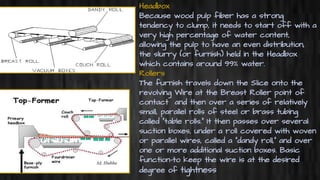The document summarizes the paper and pulp industries. It discusses that paper is made from cellulose fibers derived from wood, rags or grasses. The pulp and paper industry converts these fibers into pulp and paper. Wood is broken down mechanically or chemically into fibers, which are then mixed with water and dried to form paper. The key raw materials are fibers from wood or non-wood sources, chemicals for pulping, energy, and water. The major pulping processes are mechanical, chemical (kraft and sulfite), and semichemical. Paper is manufactured using a paper making machine that removes water from the pulp to form a continuous paper sheet.



























































